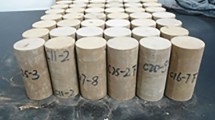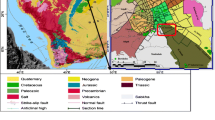Abstract
Water–rock interaction is a common phenomenon in rock mass engineering. Water–rock interaction alters the mineralogical and microstructural properties of a rock mass and leads to engineering problems such as leakage, deformation, and failure of a rock mass. To investigate the local leakage in the limestone reservoir, limestone specimens were taken from the underground chamber. In this study, two test conditions were designed: with and without regular replacement of the reservoir water condition. The results indicated that the porosity increased sharply in the early stages of the soaking. But, the rate of increment dropped after 120 d (regular replacement of reservoir water condition) and 90 d (unchanged reservoir water condition), respectively. The pore in the rock was 4.50 mm deep, while the reservoir water was replaced regularly, which is 1.54 times that of the unchanged reservoir water condition (i.e., 2.50 mm), in 360 soaking days. Relatively, the renewal of reservoir water enhanced the chemical reaction. The water–rock interaction altered the mineralogical composition, spatial structure of the crystal, and pore structure of the rock. The change in the longitudinal wave velocity Vm measures the state of pore development. The porosity evolution model for limestone rock was established by considering the impact of dissolution on the spatial structure of the crystal skeleton. The model accurately predicted the variation trend of porosity in the limestone rock under water–rock interaction.
















Similar content being viewed by others
References
Alexandrowicz Z, Marszałek M, Rzepa G (2014) Distribution of secondary minerals in crusts developed on sandstone exposures. Earth Surf Proc Land 39:320–335
Anabaraonye BU, Crawshaw JP, Trusler JP (2019) Brine chemistry effects in calcite dissolution kinetics at reservoir conditions. Chem Geol 509:92–102
Asadollahpour E, Hashemolhosseini H, Baghbanan A, Mohtaramia E (2019) Redistribution of local fracture aperture and flow patterns by acidizing. Int J Rock Mech Min 117:20–30
Baud P, Zhu WL, Wong TF (2000) Failure mode and weakening effect of water on sandstone. J Geophys Res 105:16371–16389
Bouchelaghem F (2010) A numerical and analytical study on calcite dissolution and gypsum precipitation. Appl Math Model 34:467–480
Carcione JM, Ursin B (2016) On Fermat’s principle and Snell’s law in lossy anisotropic media. Geophysics 81:107–116
Dong SJ, Subhas AV, Rollins NE, Naviaux JD, Adkins JF, Berelson WM (2018) A kinetic pressure effect on calcite dissolution in seawater. Geochim Cosmochim Acta 238:411–423
Eang KE, Igarashi T, Kondo M, Nakatani T, Tabelin CB, Fujinaga R (2018) Groundwater monitoring of an open-pit limestone quarry: Water-rock interaction and mixing estimation within the rock layers by geochemical and statistical analyses. Int Journal Min Sci Techno 28:849–857
Elsayed M, Isah A, Hiba M, Hassan A, Garadi K A, Mahmoud M, Husseiny AE, Radwan AE (2022) A review on the applications of nuclear magnetic resonance (NMR) in the oil and gas industry: laboratory and field-scale measurements. J Petrol Explor Prod Technol 1–38
Fang JC, Deng HF, Li JL, Eleyas A (2021) Study on the seepage characteristics and degradation mechanism of a single-jointed sandstone under the cyclic dry-wet process in the Three Gorges reservoir. Bull Eng Geol Environ 80:1–14
Flukiger F, Bernard D (2009) A new numerical model for pore scale dissolution of calcite due to CO2 saturated water flow in 3D realistic geometry: Principles and first results. Chem Geol 26:171–180
Gan ZQ, Pan X, Tang HZ, Huang JZ, Dong SM, Hua W (2021) Experimental investigation on mixed mode I-III fracture characteristics of sandstone corroded by periodic acid solution. Theor Appl Fract Mec 114:103034
He JY, Okere CJ, Su GD, Hu PJ, Zheng LS, Wei X, Li ZH (2021) Formation damage mitigation mechanism for coalbed methane wells via refracturing with fuzzy-ball fluid as temporary blocking agents. J Nat Gas Sci Eng 90:103956
Jiang PM (1989) Foundation of geological thermodynamics. Science Press, Beijing
Jiang Q, Deng HF, Li JL, Luo ZS, Assefa E, Fang JC, Xiao Y (2019) The degradation effect and mechanism by water-rock interaction in the layered sandstone in the Three Gorges reservoir area. Arab J Geosci 12:722
Krawczyk WE, Ford DC (2006) Correlating specific conductivity with total hardness in limestone and dolomite karst waters. Earth Surf Proc Land 31:221–234
Lasga AC, Kirkpatrick RJ (1989) Geochemistry process dynamics. Science Press, Beijing
Li GL, Yu LY, Su HJ, Jing HW, Zhang T (2018) Dynamic properties of corroded limestone based on SHPB. Chin J Rock Mech Eng 37(9):2075–2083
Li SG, Huo RK, Yoshiaki FJ, Ren DZ, Song ZP (2019) Effect of acid-temperature-pressure on the damage characteristics of sandstone. Int J Rock Mech Min 122:104079
Liang WG, XiQ Y, Gao HB, Zhang CD, Zhao YS, Dusseault MB (2021) Experimental study of mechanical properties of gypsum soaked in brine. Int J Rock Mech Min 53:142–150
Linge HG (1981) Dissolution of ionic crystal surfaces. Adv Colloid Interfac 14:239–250
Ma GT, Hu XW, Yin YP, Luo G, Pan YX (2018) Failure mechanisms and development of catastrophic rockslides triggered by precipitation and open-pit mining in Emei, Sichuan, China. Landslide 15:1401–1414
Ma HF, Song YQ, Chen SJ, Yin DW, Zheng JJ, Shen FX, Li XS, Ma Q (2021) Experimental investigation on the mechanical behavior and damage evolution mechanism of water-immersed gypsum rock. Rock Mech Rock Eng 54:4929–4948
Okere CJ, Su GD, Zheng LH, CaiYZ LZC, Liu H (2020) Experimental, algorithmic, and theoretical analyses for selecting an optimal laboratory method to evaluate working fluid damage in coal bed methane reservoirs. Fuel 282:118513
Okere CJ, Zheng LH, Su GD, Liu H, Chang QF, Obiafudo OJ (2021) Critical analysis of productivity of well 2L after foam-acid diversion. Mech Mach Sci 99:21–36
Olivier S, Claire L, Alfonso M, Boudreau BP (2017) Calcite dissolution kinetics at the sediment-water interface in natural seawater. Mar Chem 195:70–83
Radwan AE, Trippetta F, Kassem AA, Kania M (2021) Multi-scale characterization of unconventional tight carbonate reservoir:insights from October oil field, Gulf of Suez rift basin. Egypt J Petrol Sci Eng 197:107968
Ruiz AE, Kowacz M, Putnis CV, Putnis A (2010) The role of background electrolytes on the kinetics and mechanism of calcite dissolution. Geochim Cosmochim Acta 74:1256–1267
Sausse J, Jacquot E, Fritz B, Leroy J, Lespinasse M (2001) Evolution of crack permeability during fluid–rock interaction. Example of the Brézouard granite (Vosges, France). Tectonophysics 336:199–214
Shang DL, Zhao ZH, Dou ZH, Yang Q (2020) Shear behaviors of granite fractures immersed in chemical solutions. Eng Geol 279:105869
Subhas AV, Rollins NE, Berelson WM, Dong S, Erez J, Adkins JF (2015) A novel determination of calcite dissolution kinetics in seawater. Geochim Cosmochim Acta 170:51–68
Tang YC, Zhou H, Feng XT, Xie YT (2008) Study on dissolving model under effect of stress for rock salt. Rock Soil Mech 29:296–302
Tao XJ, Okere CJ, Su GD, Zheng LH (2022) Experimental and theoretical evaluation of interlayer interference in multi-layer commingled gas production of tight gas reservoirs. J Petrol Sci Eng 208:109731
Tu GZ, Lu HZ, Hong YT (1999) Advanced geochemistry. Science Press, Beijing
Volkov AA, Vasin AA, Volkov AA (2019) Are water and ice normal polar dielectrics? polarization mechanism. Ferroelectrics 544:38–42
Wang T, Qian TW, Zhao DY, Liu XN, Ding QW (2020) Immobilization of perrhenate using synthetic pyrite particles: Effectiveness and remobilization potential. Sci Total Environ 725:138423
Yang XJ, Wang JM, Hou DG, Zhu C, He MC (2018) Effect of dry-wet cycling on the mechanical properties of rocks: a laboratory-scale experimental study. Processes 6:199
Yuan HM, Han DH, Huang Q (2019) Porosity measurement of heavy oil sands. Geophys Prospect 76:1072–1081
Zhang Q, Wang J, Hou LL, Lin P (2018) Study on the instability mechanisms and monitoring control of stratified rock slope with water-rich strata. Geotech Geol Eng 36:1665–1672
Zhu C, Xu XD, Liu WR, Xiong F, Lin Y, Cao C, Liu X (2019) Softening damage analysis of gypsum rock with immersion time based on laboratory experiment. IEEE Access 7:125575–125585
Funding
This work has been funded by the National Natural Science Foundation of China (Nos. U2034203, 51979218), the Open Research Fund of Key Laboratory of Construction and Safety of Water Engineering of the Ministry of Water Resources, China Institute of Water Resources and Hydropower Research (No. 202001), and it was also sponsored by the Research Fund for Excellent Dissertation of China Three Gorges University (No. 2020BSPY001). The authors acknowledge the referees for the great work they did in reviewing this paper.
Author information
Authors and Affiliations
Corresponding author
Ethics declarations
Conflict of interest
The authors declared that they have no conflicts of interest to this work.
Rights and permissions
Springer Nature or its licensor holds exclusive rights to this article under a publishing agreement with the author(s) or other rightsholder(s); author self-archiving of the accepted manuscript version of this article is solely governed by the terms of such publishing agreement and applicable law.
About this article
Cite this article
Xiao, Y., Deng, H., Li, G. et al. Pore structure characteristics of an underground limestone chamber in the Three Gorges Reservoir area. Bull Eng Geol Environ 81, 358 (2022). https://doi.org/10.1007/s10064-022-02863-0
Received:
Accepted:
Published:
DOI: https://doi.org/10.1007/s10064-022-02863-0




